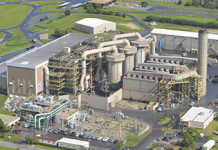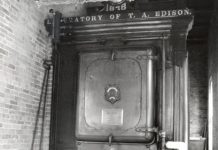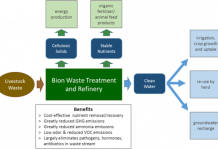by Debra Fiakas CFA
![]() In October 2009, the U.S. Department of Energy selected a dozen projects aimed at bringing relief to a planet suffocating in a cloud of toxic carbon dioxide emissions. The DOE called the program it’s Large-Scale Industrial Carbon Capture Storage Projects and wrote checks for $575 million out of American Recovery and Reconstruction (ARRA) funds. A little more than a year later the DOE weeded out all but three projects for the second phase of the program. Besides Leucadia Energy (subsidiary of Leucadia National, LUK: NYSE) and Archer Daniels Midland (ADM: NYSE), the DOE tapped Air Products and Chemicals, Inc. (APD: NYSE) to move forward with design and construction of their carbon capture schemes.
In October 2009, the U.S. Department of Energy selected a dozen projects aimed at bringing relief to a planet suffocating in a cloud of toxic carbon dioxide emissions. The DOE called the program it’s Large-Scale Industrial Carbon Capture Storage Projects and wrote checks for $575 million out of American Recovery and Reconstruction (ARRA) funds. A little more than a year later the DOE weeded out all but three projects for the second phase of the program. Besides Leucadia Energy (subsidiary of Leucadia National, LUK: NYSE) and Archer Daniels Midland (ADM: NYSE), the DOE tapped Air Products and Chemicals, Inc. (APD: NYSE) to move forward with design and construction of their carbon capture schemes.
Like Praxair, Inc. (PX: NYSE), which was profiled in the last post “Praxair’s Long Road to Carbon Capture,” Air Products is a supplier of industrial gases. Oxygen appears to be a key requirement of carbon capture technology, and both suppliers are actively working to cultivate the market by pushing carbon capture demonstration projects.
For its part Air Products is to build a system to concentrate carbon dioxide (CO2) from two steam methane reformer (SMR) hydrogen production plants located in Port Arthur, Texas. The two plants are being retrofitted with using vacuum swing adsorption (VSA) technology to separate CO2 from the gas streams coming out of the SMRs. After capture the CO2 will be concentrated to 97% purity and shipped to the West Hasting oil and gas fields in Texas. The CO2 will be injected in underground formations to help squeeze out so-called “shut in” oil in late-stage oil fields. In January 2013, the DOE announced Air Products had gone fully operational in Port Arthur and declared the project a success.
Air Products estimates that as much as 90% of the CO2 can be removed from the gas stream and apparently in the initial weeks of operation the yield has been as much as 97%. That is an impressive accomplishment, if it can be deployed widely across industrial and power generation sectors. At what cost?
The Port Arthur project had a $430.0 million price tag, for which Air Products received $284.0 million in grant monies from the ARRA. For the trouble, Air Products estimates that approximately 1.0 million metric tons of CO2 will get removed from the atmosphere and an incremental 1.6 million barrels of oil will result from the injection and storage stage. At current West Texas crude prices the oil represents over $150 million in value. Certainly, that justifies an attractive sales price for the CO2 concentrate.
From another angle, the two hydrogen plants in Texas represent less than 5% of hydrogen production capacity for refinery use in the U.S. Thus if Air Products’ CO2 capture demonstration remains successful, there may be some chance to recover its investment with technology licenses or sales.
Calculation of that revenue might be akin to putting the cart before the horse. There is nothing new about the vacuum swing adsorption (VSA) technology that Air Products is relying on to tease out the carbon dioxide from the rest of the gas stream. The adsorbents are special solids mixed to attract particular gases and act like a molecular sieve to adsorb the target gas – in this case CO2. This takes place at ambient air temperatures and pressure. After the CO2 is separated, the system “swings” to the vacuum phase where the adsorbents are regenerated. VSA is already used in refineries, chemical plants and water treatment facilities to purify air, and to manufacture oxygen, nitrogen and hydrogen.
No matter how well established in applications for ordinary gases, VSA is only just now being proven effective for CO2 separation. If it really works in practice, the VSA technology could overcome one of the many criticisms of carbon capture – prohibitively high cost. Remember the process works at ambient temperature and pressure, which means that less energy is needed to start and run the gas separation step. VSA systems also require less maintenance. Will VSA economy be enough to make economically feasible to layer this added equipment onto the normal costs of running the hydrogen plant?
Air Products reported $9.9 billion in total sales in the last twelve months, providing $1.1 billion in net income. That measured out to $5.59 per share. Those impressive numbers and not some unproven, but politically popular carbon capture project are what drive Air Products shares. The company pays out as much as 46% of net income and over the next year shareholders expect to get $2.56 per share in dividends. Based on the stock price at the time of this post the forward dividend yield was 2.9%. Add that to the average projected growth rate of 9% and shareholders have quite a bit to look forward to in Air Products shares. That said, the stock is trading at 13.8 times earnings expected next year, suggesting the stock is fully priced.
Debra Fiakas is the Managing Director of Crystal Equity Research, an alternative research resource on small capitalization companies in selected industries.
Neither the author of the Small Cap Strategist web log, Crystal Equity Research nor its affiliates have a beneficial interest in the companies mentioned herein.








